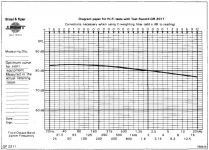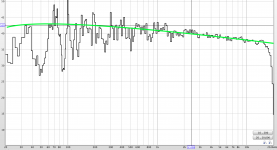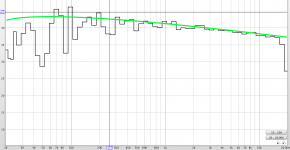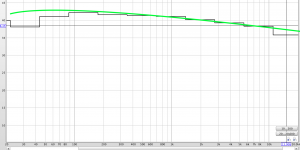Frequency response is just one of many parameters. Look at Seas Magnesium drivers. The freq. responses are just terrible compared to a typical paper driver, but I would take them everyday vs. any paper driver.
In general, the more flat the freq. response, the less the detail. The more the the break up, the more the detail. Sounds a bit contradictory but it's truth. I guess maybe eventually somebody will come up with a driver with good frequency response and detail as well.
It's my blond with golden heart theory.
In general, the more flat the freq. response, the less the detail. The more the the break up, the more the detail. Sounds a bit contradictory but it's truth. I guess maybe eventually somebody will come up with a driver with good frequency response and detail as well.
It's my blond with golden heart theory.
kinsei, I'm sorry that you have had a few rude responses to your question. Even if they come from very knowledgable people and contain useful information, rude tones are not warranted.
I know much less about audio than most of the people here. I haven't read the Toole book either. However, I've made a fair number of speakers and have used miniDSP to flatten the frequency response on many of them. More often than not, I prefer the sound without major frequency power correction. Perhaps phase corrections like Wesayso makes are just as important and the way forward. I don't know!
I know much less about audio than most of the people here. I haven't read the Toole book either. However, I've made a fair number of speakers and have used miniDSP to flatten the frequency response on many of them. More often than not, I prefer the sound without major frequency power correction. Perhaps phase corrections like Wesayso makes are just as important and the way forward. I don't know!
IMO/IME, Breakup is distortion and not detail. You can have detail and low HD.
Wolf
Yes, break up is distortion. That's why you can filter out the distortion at high frequency.
Citing the equal loudness curve, when talking about the frequency response of systems, is irrelevant, think about it.thanks for the many replies
surprisingly it seems that many (if not most) of you guys are using FR as the only and ultimate way to measure objective sound quality, sorry no way for me, flat FR is just a basic requirement and not the whole story.
speaker design books has little to do here (its main goal is just SPL correction), and i would rather prefer "The Audio Measurement Handbook" as discussed here:
Is there an objective way to measure sound quality? Audio community often cite uneven frequency in highs, mids and lows as poor audio quality, but how is that perceptually negative to someone who listens to music? - Quora
I'm having a bit of a revelation here... Using a DAC where it is possible to introduce EQ biquads in a almost lossless manner, I have tuned my FR to quite tight tolerances, measured in my listening position. I do this by making a circular motion (40 cm dia.) with the mic pointing in the same direction as my nose playing pink noise in both channels. I use REW RTA with 4x averaging. I have chosen the old B&K target curve as my goal. As I'm approaching +/-1dB over most of the range I'm beginning to get reproduction that really outperform anything I have had before. The system was well performing before but now it's really magic. If you have a good start I would recommend to try to make it "flat" - it appears to effect a lot of aspects of the sound - all it seems 
So for me "flat" means maybe "even" and it seem to be a requirement for accurate reproduction - but it's most probably not the only requirement.
//
PS. The three graphs are from the one and same measurement. Still, a little more energy en the lower region is needed
So for me "flat" means maybe "even" and it seem to be a requirement for accurate reproduction - but it's most probably not the only requirement.
//
PS. The three graphs are from the one and same measurement. Still, a little more energy en the lower region is needed
Attachments
Last edited:
Yes, break up is distortion. That's why you can filter out the distortion at high frequency.
Then I don't understand your previous post.
Wolf
Depending on what you are doing, there are many ways to make a mess of the sound with DSP and EQ.kinsei, I'm sorry that you have had a few rude responses to your question. Even if they come from very knowledgable people and contain useful information, rude tones are not warranted.
I know much less about audio than most of the people here. I haven't read the Toole book either. However, I've made a fair number of speakers and have used miniDSP to flatten the frequency response on many of them. More often than not, I prefer the sound without major frequency power correction. Perhaps phase corrections like Wesayso makes are just as important and the way forward. I don't know!
Phase anomalies in a speaker driver would be displayed in the frequency response
If you have a good start I would recommend to try to make it "flat" - it appears to effect a lot of aspects of the sound - all it seems
So for me "flat" means maybe "even" and it seem to be a requirement for accurate reproduction - but it's most probably not the only requirement.
It's obviously tempting for us all to drift off into analysing speaker systems and rooms and hearing, but the OP did ask about speaker drivers. So my question would be, what aspects of the driver's sound are not displayed in the frequency response? In fact I shall direct that question to him also
Last edited:
What aspects of the speaker driver's sound are not displayed in the FR?thanks for the many replies
surprisingly it seems that many (if not most) of you guys are using FR as the only and ultimate way to measure objective sound quality, sorry no way for me, flat FR is just a basic requirement and not the whole story.
Manger's speakers are supposed to have the worst performance of all transducers on the market?
I do not think so...
Pistonic movement is not related to the quality of signal processing.
The sound is just sines because nothing else can be transmitted by a medium with a constant speed of the stimulation.
So the bandwidth seems the most important ability of the speaker, assuming that nonlinear distortions are kept under control.
Findings of Jon Bocani from this forum confirmed this...
I can not maintain the faith I had long ago that the material of the membrane determines the quality of processing the details.
But this does not mean that there is no room for doubts.
There are very few measurements when the signal strength decreases from typical levels.
Rigid membranes are usually light, so their suspensions can be more delicate and here I would see the consequences for the quality of processing.
Various mechanical parameters of the suspension in relation to Mms mean a lot especially in tweeters.
Take a look at the measurements of distortions vs power for many years posted in the German monthly "Hobby Hifi".
Unfortunately, the bottom of the scale was limited at 20mV, which is still very strong driving signal.
However, despite this, these measurements give a lot to think about.
I do not think so...
Pistonic movement is not related to the quality of signal processing.
The sound is just sines because nothing else can be transmitted by a medium with a constant speed of the stimulation.
So the bandwidth seems the most important ability of the speaker, assuming that nonlinear distortions are kept under control.
Findings of Jon Bocani from this forum confirmed this...
I can not maintain the faith I had long ago that the material of the membrane determines the quality of processing the details.
But this does not mean that there is no room for doubts.
There are very few measurements when the signal strength decreases from typical levels.
Rigid membranes are usually light, so their suspensions can be more delicate and here I would see the consequences for the quality of processing.
Various mechanical parameters of the suspension in relation to Mms mean a lot especially in tweeters.
Take a look at the measurements of distortions vs power for many years posted in the German monthly "Hobby Hifi".
Unfortunately, the bottom of the scale was limited at 20mV, which is still very strong driving signal.
However, despite this, these measurements give a lot to think about.
Last edited:
It's obviously tempting for us all to drift off into analysing speaker systems and rooms and hearing, but the OP did ask about speaker drivers. So my question would be, what aspects of the driver's sound are not displayed in the frequency response? In fact I shall direct that question to him also
We'd first have to make sure to be measuring the speaker alone/by itself. That in itself is not an easy task. In fact, the moving microphone as TNT suggests 'could' get you closer to that ideal.
If one measures at one spot in a room, you include all anomalies that happen at that single spot in to the measurement. The more measurement spots you include and average afterwards, the less the individual anomalies of one of those single spots will play a role in the overal measurement. However, there will still be influence from the room in that measurement.
Ideally, to get the speaker response only, you'd measure in a reflection free environment (anechoic chamber or outside measurements done with care, last resort being gated measurements indoors) and yes, it would make sense to go for a flat response under those conditions. But when those measurements are done in a room (without gating)?
There are other reasons flat may not sound good as well. Unless you listen to a mono speaker. But it's not a bad start, even for stereo, if you are sure you are measuring the speaker by itself and not speaker + room.
Don't be too quick to judge the speaker driver. Be sure you've done it right!
Personally I don't see EQ as a poison, but it's important to learn what to look at/for. I try to get the room out of the equation, partly by the way I take the measurements and filter them and partly by treating the 'in room' effects as seen from the listening spot (treating/targeting early reflection points). It has served me well. But my "in room" target for frequency response is not flat.
Last edited:
speaker design books has little to do here (its main goal is just SPL correction),
...which just goes to show that you have no idea what's actually in Toole's Book. Or how you could be educated by reading it.
Oh, well. Your loss.
I'm not sure if the first post is talking about individual drivers with flat response, or the final speaker using multiple drivers with flat response.
If you are making a multiway speaker it doesn't matter how flat or not flat the individual drivers are, if you don't cross them over well to get good summing and a hopefully relatively flat final result and a reasonably even power response, then they will likely sound bad.
You can make a crossover that blend two drivers in a way that produces a relatively flat on axis frequency response that sounds absolutely horrible. You can design another crossover that blends the same drivers properly and still have a very similar looking on axis frequency response that sounds fantastic in comparison. So yes a flat on axis frequency response is not everything, but no one said it was.
Almost everything you read will mention the off axis characteristics as being important, get that right (along with flat on axis) and you should have something that does indeed sound good.
Tony.
If you are making a multiway speaker it doesn't matter how flat or not flat the individual drivers are, if you don't cross them over well to get good summing and a hopefully relatively flat final result and a reasonably even power response, then they will likely sound bad.
You can make a crossover that blend two drivers in a way that produces a relatively flat on axis frequency response that sounds absolutely horrible. You can design another crossover that blends the same drivers properly and still have a very similar looking on axis frequency response that sounds fantastic in comparison. So yes a flat on axis frequency response is not everything, but no one said it was.
Almost everything you read will mention the off axis characteristics as being important, get that right (along with flat on axis) and you should have something that does indeed sound good.
Tony.
Last edited:
The first post is so full of pedantic nonsense it hardly mattersI'm not sure if the first post is talking about individual drivers with flat response, or the final speaker using multiple drivers with flat response.
Sounds like my room, cork floor tiles, is that ok? Large sofa behind my listening chair, how are we doing? I listen nearfield with speakers crossing in front of me, is everything lost?True if your room has tiled floors, little furnishing and bare walls then all bets are off
Tony.
There are many things which determine how a driver sounds apart from the FR: cone material; cone shape; surround; motor assembly; off axis response; parameters, etc.
Oh, and of course, implementation - the most important aspect of sound quality
Well, all of that ends up influencing and being displayed in .... the frequency response
To make it even more clear: changing any of the factors you mentioned will change frequency response.
To be even more precise: you do NOT hear
by themselves, but the resulting ... frequency response ....cone material; cone shape; surround; motor assembly
- Status
- Not open for further replies.
- Home
- Loudspeakers
- Multi-Way
- speaker drivers: flat frequency response does NOT mean good sound quality



